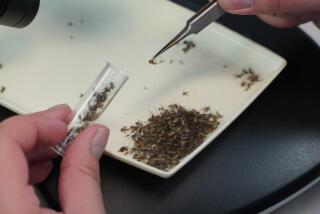SAN JUAN CAPISTRANO : Homeowner Is Stuck With Skunk
- Share via
Gerry Schaffner believes there is a skunk under the deck of his house near the San Juan Hills Golf Course.
Although he hasn’t actually seen it, he says he can tell it’s a skunk by the cat-sized hole it keeps digging in the ground. Schaffner knows the telltale signs: Before he moved here two years ago, four of the critters took up residence at various times under the porch of his home in Dana Point. One even delivered babies.
On those occasions, Schaffner trapped the skunks and called in county animal control officers to euthanize them and cart off the remains.
But this time county officers won’t come anywhere near.
As of Aug. 1, skunks were removed from the county’s list of animals routinely killed upon capture. Even though the animals pose a high risk of carrying rabies, it has been years since any local skunk was found to be infected with the disease.
So now animal control officers, mostly busy tracking down potentially rabid dogs, turn away the three or four calls they get each day from South County residents confronted by skunks.
County officials say it is a dilemma that illustrates the increasing urbanization of Orange County--wildlife on the run.
Schaffner, however, views it more as an example of government regulation run amok.
“I pay $3,000 in county property taxes and I don’t see why I have to co-exist with this animal that may or may not have rabies,” Schaffner complained. “I am caught in a Catch-22. If I trap an animal, I don’t know what I would do with it. I don’t want to keep it and they (county officials) told me if I kill it, I would be breaking the law.”
Kevin R. Whelan, chief of field services for county animal control, said his officers will come to the aid of people who fear they have been sprayed or bitten by a skunk. But he confirms that officials are mostly concerned about handling domestic animals, not wildlife. With about 50 officers to cover 21 cities and Orange County’s unincorporated areas, animal control has received about 31,000 calls for help so far this year, the vast majority of them involving stray dogs and cats.
The county conducts tests on trapped skunks each year to make sure there is no resurgence of rabies, Whelan explained, but the only wild animal that still is immediately killed because of its rabies risk is the bat.
Before the skunk was removed from the so-called euthanasia list--partly due to pressure from animal-rights advocates--officers routinely killed skunks with chloroform.
Kent Smith, a spokesman for the state Department of Fish and Game, said the skunk is a “non-protected” species that may be killed at any time of the year under law, like other pesky birds and animals, among them English sparrows, coyotes, weasels, opossums, moles and rodents.
Whelan said animal control officers are happy to give residents advice on how to kill a skunk--among other things, dry ice can be used to freeze the animal or any of several over-the-counter chemical substances can be placed in a trap.
If Whelan chooses to relocate the skunk rather than kill it, that raises other problems. Regulations state that an animal may not be removed from its natural habitat.
“You know what that means,” Schaffner scoffed. “The skunk will be back under the deck the next night where it is warm and dry. I know enough about skunks to know they are hard to get rid of and when you have one, there is a good chance you’ll have a whole family come spring.
“I don’t know what I am going to do. But I am going to have to do something,” Schaffner said. “This is a sign of a bureaucracy at its pinnacle. They tax you a lot for a service and then tell you to do it yourself.”
More to Read
Sign up for Essential California
The most important California stories and recommendations in your inbox every morning.
You may occasionally receive promotional content from the Los Angeles Times.










